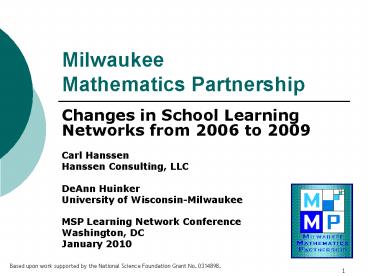Milwaukee Mathematics Partnership - PowerPoint PPT Presentation
1 / 19
Title:
Milwaukee Mathematics Partnership
Description:
... used primarily as a resource Teachers assume math leadership * Sociograms Review Work in groups of 2-3 Evaluate the sociogram-pairs for distributed ... – PowerPoint PPT presentation
Number of Views:90
Avg rating:3.0/5.0
Title: Milwaukee Mathematics Partnership
1
Milwaukee Mathematics Partnership
- Changes in School Learning Networks from 2006 to
2009 - Carl Hanssen
- Hanssen Consulting, LLC
- DeAnn Huinker
- University of Wisconsin-Milwaukee
- MSP Learning Network Conference
- Washington, DC
- January 2010
Based upon work supported by the National Science
Foundation Grant No. 0314898.
2
Agenda
- Context
- Questions Methods
- Review Sociograms
- Results
- Conclusions Discussion
3
MMP Goals
- Comprehensive mathematics framework
- Distributed leadership
- Teacher learning continuum
- Student learning continuum
4
MMP Status
- Funding
- Year 7 MSP Phase I Award
- Year 2 MSP Phase II Award
- Year 2 sustaining funding from the State of
Wisconsin for released MTL positions - Important strategic shiftimplementation of the
released-time MTL Model beginning in the second
half of 2007-2008 school year.
5
Key Questions
- What changes have been observed in school-based
learning networks from 2006 to 2009? - How does Social Network Analysis help us
understand changes in learning networks?
6
Methods
- Open SNA survey approachno fixed list of network
members - Key SNA QuestionList individuals you have
communicated with about mathematics education in
thepast several months. - Demographics collected for eachindividual named
on the survey
7
Analysis
- Sociograms
- MTL
- MTS or
- Teachers
- Principal
- Literacy Coach
- Others in school
- Others outside
- Statistics
- Total Respondents
- Total Named
- Network density
- In-School density
- MTL In-Degree
- MTS In-Degree
8
MMP Distributed Leadership Continuum
Low
High
1
2
3
4
5
Loose Network MTL Not Central Few Links to
MTL MTS Outside Few Links to MTS Leadership
responsibility of few
Tight Network MTL Central Many Links to MTL MTS
Inside Many Links to MTS Leadership is shared
among many
9
Evolution of Distributed Leadership
- MTL is active within the school
- Teachers begin extensive collaboration
- MTL Teacher collaboration extends outside
school (MTS may become heavily involved in the
school) - MTL is used primarily as a resource
- Teachers assume math leadership
10
Sociograms Review
- Work in groups of 2-3
- Evaluate the sociogram-pairs for distributed
leadership characteristics (10 minutes) - Make a judgment about learning network changes in
that school - Report back
11
Pair A
12
Pair B
13
Pair C
14
Summary Results (n11)
15
Summary Results (n11)
16
Summary Results (n11)
17
Conclusions
- Introduction of the MTL role has had an impact on
changes in school-based learning networks. - The shift to a released-time MTL model is
manifested in lower in-school network density but
higher MTL importance. - This change has presents an alternative to past
perspectives on distributed leadership.
18
AlternativeEvolution of Distributed Leadership
- MTL is active within the school
- Teachers begin extensive collaborationTeachers
increase communication - MTL Teacher collaboration extends outside
school - MTL is used primarily as a resourceMTL becomes
focal point for math - Teachers assume math leadershipTeachers defer to
MTL for math leadership
19
Next Steps
- Continue collected SNA data from 25 case study
schools in 2010 and 2011 - Examine trends
- Look at relationships to other metrics































